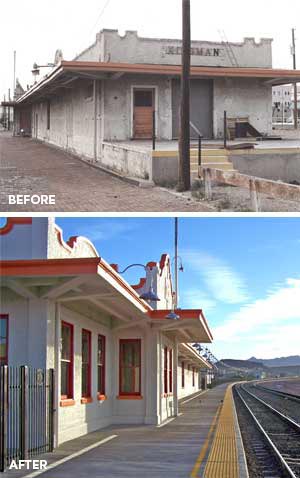America’s rail stations have witnessed history unfold and played host to some of our nation’s most difficult and proudest moments. Stations are pieces of our country’s history and treasures not to be lost or forgotten.
Recognizing the value in historic preservation, communities are banding together to preserve and promote their stations’ historical significance. Additionally, many stations are listed, or qualify for listing, on local, state and national historic registers. Listing can increase awareness of a station’s history and may allow an owner to take advantage of federal and state historic preservation tax credits.
Benefits of Historic Preservation Include:
- Economic development
- City center revitalization
- Tourism (particularly heritage tourism)
- Job creation
- Community pride
Kingman, Ariz., Restores a Route 66 Landmark
 By the early 2000s, the Kingman, Ariz. depot was in disrepair and closed to the public—train travelers used a small waiting room located in a nearby storefront. The poured concrete depot, built by the Atchison, Topeka and Santa Fe Railway in 1907, has an undulating roofline characteristic of Spanish Mission Revival design. Recognizing the historic importance of the building and its status as a Route 66 landmark, the city began searching for grants to support a full rehabilitation.
By the early 2000s, the Kingman, Ariz. depot was in disrepair and closed to the public—train travelers used a small waiting room located in a nearby storefront. The poured concrete depot, built by the Atchison, Topeka and Santa Fe Railway in 1907, has an undulating roofline characteristic of Spanish Mission Revival design. Recognizing the historic importance of the building and its status as a Route 66 landmark, the city began searching for grants to support a full rehabilitation.
In 2002, Kingman won $471,500 in federal Transportation Enhancements (now known as Transportation Alternatives) funding administered through the Arizona Department of Transportation. The city provided a $28,500 local match, and additional funding was provided through the city, Amtrak, the local historic preservation society and the federal Community Development Block Grant (CDBG) program.
Since the depot is located in a local Historic Overlay District and is listed as a contributing structure in the National Register Kingman Commercial Historic District, the rehabilitation work was subject to review by the city’s Historical Preservation Commission (HPC) and the Arizona State Historic Preservation Office (SHPO). After identifying grant funding opportunities, the rehabilitation plan was presented to the HPC, which provided comments before endorsing the project to the City Council.
The city chose to work with Otwell Associates Architects, a firm specializing in historic preservation projects. Staff was experienced in using the Secretary of the Interior’s Standards for the Treatment of Historic Properties, a set of guidelines concerning the rehabilitation, restoration and preservation of historic structures. These standards must be followed for any historic preservation project receiving federal funds, and the city had to assure the SHPO that they were factored into the final design.
Rehabilitation work included repairs to the exterior stucco, restoration of the original doors and windows, refinishing of concrete floors, installation of new heating, plumbing and electrical systems, painting and landscaping. As part of the project, Amtrak constructed a new ADA accessible, 700-foot long concrete platform with tactile edging. New light standards along the platform create a welcoming glow as the west and east bound trains stop in the evening, and a fence incorporates the classic Santa Fe Railway logo.
Following years of planning and patience, the depot officially reopened in spring 2011. The swooping gables, canopy edge and window and door frames are painted a vibrant orange that calls attention to the depot and affirms its role as the centerpiece of downtown’s revival. One half of the depot is used for the Amtrak waiting room and office space, and the other half houses a railroad museum that has become a popular tourist attraction.


 Amtrak established the Great American Stations Project in 2006 to educate communities on the benefits of redeveloping train stations, offer tools to community leaders to preserve their stations, and provide the appropriate Amtrak resources.
Amtrak established the Great American Stations Project in 2006 to educate communities on the benefits of redeveloping train stations, offer tools to community leaders to preserve their stations, and provide the appropriate Amtrak resources. For more than 50 years, Amtrak has connected America and modernized train travel. Offering a safe, environmentally efficient way to reach more than 500 destinations across 46 states and parts of Canada, Amtrak provides travelers with an experience that sets a new standard. Book travel, check train status, access your eTicket and more through the
For more than 50 years, Amtrak has connected America and modernized train travel. Offering a safe, environmentally efficient way to reach more than 500 destinations across 46 states and parts of Canada, Amtrak provides travelers with an experience that sets a new standard. Book travel, check train status, access your eTicket and more through the